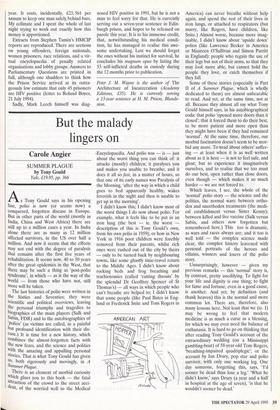Not at liberty to choose
Peter J. M. Wayne
THE PRISONERS' HANDBOOK, 1995 by Mark Leech OUP, £30, £9.99, pp. 465 During a brief period of freedom last year, I was invited to speak at a 'Roots of Crime' luncheon at the Grosvenor House Hotel. Sitting on my left was Terrence Morris, Professor Emeritus of Criminology and Criminal Justice at London University. He told me that during the course of his researches, he had spent several weeks as a voluntary inmate in one of HM Prisons. I blenched over the walnut and fig tart. Yet he seemed almost proud of his self- enforced incarceration. One wondered how he had chosen a suitable gaol.
In The Prisoners' Handbook, Mark Leech (an involuntary inmate of one kind or another since the age of eight) has produced what I suppose the good profes- sor might have considered essential pre- sabbatical reading.
Alphabetically, from Acklington to Wymott, the reader is taken on an odyssey covering the 120 prisons and remand centres in England and Wales. Without a doubt, we are presented with the most comprehensive survey of our penal archipelago since John Howard published his damning indictment, The State of the Prisons over 200 years ago. Plus ca change, and indeed both authors treat of many of the same establishments. Here is Howard on Oxford in 1777:
The Gaoler has a spacious garden . . . no infirmary, no bath, no straw: the prisoners lie in their clothes on mats. The men's dungeon swarms with vermin.
Then here is Leech quoting from the Board of Visitors' Annual Report on Wandsworth in 1994:
Physical conditions . .. are extremely poor: slopping out, flooding in recess, lack of show- ers, continuing cockroach infestation.
But is this publication really a prisoners' handbook? When the publicity blurb was circulated last month, the story made the front page of the Times:
Inmates of British Prisons [their reporter declared] will soon be able to consult a con- sumers' guide on the conditions, regimes and facilities they should have and the best jail to which to seek transfer.
As if Egon Ronay or Hilary Rubenstein had suddenly decided to take under their wings the disenfranchised holidaymaker. If only we did have a choice in the matter of allocation. Over the last 20 years, I have stayed in 30 of the prisons mentioned in Leech's book. I cannot once recall ever having been asked where I wanted to go next. For the most part, prisoners are told where they will be going. However, I believe the book might come in very useful once that decision has been made for us.
Every entry has been subdivided into clearly headed, informative, and succinctly written paragraphs, each dealing with a significant aspect of prison life. Accommo- dation, discipline, education, sport, the chaplaincy and medical facilities are dealt with impartially. Yet Leech is interested enough in his subject to provide brief histories of establishments, along with prisoners' comments and snippets of crimi- nal folklore. He tells us, for instance, that Wandsworth is the only prison with a work- ing set of gallows, and that Ronnie Biggs escaped from there in July 1966. He could, perhaps, have added that Mr Biggs' card- board property box still lies awaiting his return, on a shelf in reception. Prisoners are shown the moth-eaten effects, just to remind them that the law has a memory quite as long as the train robber's original sentence.
Taking into account that this volume in hardback is far beyond the financial reach of most prisoners, one imagines OUP have another potential readership in mind. Legal agents, solicitors, probation officers, doctors, journalists and criminologists would certainly do well to have copies of what we are promised will be an annually updated almanac.
The guide itself comprises only half the book. Peter Quinn, one of the most enlightened Governors in a system that produces so many other intransigent ones, contributes a long essay calling for the appointment of peripatetic and indepen- dent adjudicators legally qualified enough to sit on internal disciplinary hearings.
In another section on the 'aims, targets and priorities' of the Prison Service, mem- bers of the Law and Order camp will be relieved to read that agency boss, Derek Lewis, hopes 'to ensure that the number of escapes . . . is fewer' than the previous year. It costs, incidentally, £23, 561 per annum to keep one man safely, behind bars. My cellmate and I spent the whole of last night trying to work out exactly how this money is apportioned.
Extracts from Stephen Tumin's HMCIP reports are reproduced. There are sections on young offenders, foreign nationals, women prisoners, race relations, and a vir- tual encyclopaedia of penally related organisations and lobby groups. Answers to Parliamentary Questions are printed in full, although one shudders to think how the Prison Service arrived at its outra- geously low estimate that only 45 prisoners are HIV positive (letter to Roland Boyes, 21 July 1994).
Sadly, Mark Leech himself was diag- nosed HIV positive in 1991, but he is not a man to feel sorry for that. He is currently serving out a seven-year sentence in Edin- burgh prison, and hopes to be released on parole this year. It is to his immense credit, that, notwithstanding his medical condi- tion, he has managed to realise this awe- some undertaking. Lest we should forget the ones without his instinct for survival, he concludes his magnum opus by listing the 53 self-inflicted deaths in custody during the 12 months prior to publication.
Peter .1. M. Wayne is the author of The Architecture of Incarceration (Academy Editions, £35). He is currently serving a 13-year sentence at H. M. Prison, Blunde- ston.



























































 Previous page
Previous page